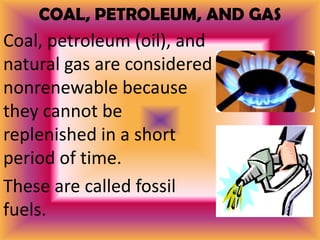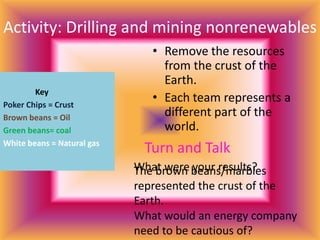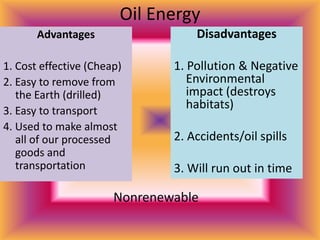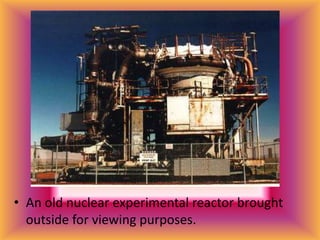Nonrenewable Energy
- 3. What are non-renewable resources? • A natural resource such as coal, gas, oil or uranium • Once consumed it cannot be replaced – (in the time frame we need it in) • Most energy resources currently in use are non-renewable
- 4. • AKA – fossil fuels and nuclear power
- 5. COAL, PETROLEUM, AND GAS Coal, petroleum (oil), and natural gas are considered nonrenewable because they cannot be replenished in a short period of time. These are called fossil fuels.
- 6. Activity: Drilling and mining nonrenewables Key Poker Chips = Crust Brown beans = Oil Green beans= coal White beans = Natural gas • Remove the resources from the crust of the Earth. • Each team represents a different part of the world. Turn and Talk What were beans/marbles The brown your results? represented the crust of the Earth. What would an energy company need to be cautious of?
- 7. Coal Mining Video 5:43 minutes Coal
- 8. HOW IS COAL MADE ???
- 9. Coal Energy Advantages Disadvantages 1. Cost effective (Cheap) 2. Easy to remove from the Earth (mined by machine or hand) 3. Easy to transport to different locations 1. Pollution & Negative Environmental impact (destroys habitats) 2. Mining accidents 3. Will run out in time Nonrenewable
- 10. Oil petroleum exploration and refining process 8:34 Extreme Oil Drilling Video (3:04) Did you know? Petroleum (oil) is refined (changed) after it is drilled out of the ground. One type of refined oil is gasoline (the stuff we fill our cars up with). The phrase “put gas in the car” is not really a true statement because “gas” isn’t really a GAS at all! It is a liquid and just a short form of the word gasoline.
- 11. Oil Energy Disadvantages Advantages 1. Cost effective (Cheap) 2. Easy to remove from the Earth (drilled) 3. Easy to transport 4. Used to make almost all of our processed goods and transportation 1. Pollution & Negative Environmental impact (destroys habitats) 2. Accidents/oil spills 3. Will run out in time Nonrenewable
- 12. Review: HOW ARE OIL AND GAS MADE ???
- 13. Natural Gas Energy 101: Natural Gas Power Plants Video (3:30) Remember, gasoline is NOT natural gas. Gasoline is refined oil. Texas is full of GAS!!!
- 14. Natural Gas Energy Advantages 1. Less air pollution than oil and coal 2. Makes a lot of electricity 3. Easy to transport Disadvantages 1. Negative Environmental impact (destroys habitats) 2. Some pollution 3. Explosive/dangerous Nonrenewable
- 15. Nuclear Power • Look familiar?
- 16. NUCLEAR ENERGY Nuclear fission uses uranium to create energy. Nuclear energy is a nonrenewable resource because once the uranium is used, it is gone!
- 17. Mrs. Smith visited the Idaho National Laboratory – an experimental nuclear power plant Where was it? In Arco, Idaho Was it a little nerve racking? YES! - Why? Because I was afraid there would be a Nuclear MELTDOWN while she was there and she would get massive amounts of radioactive waste on her and come out with 3 eyes and 28 fingers… How awesome was it? VERY AWESOME!!!!
- 18. Where is Arco, Idaho?... • … In the middle of no where! • It is not used as just a nuclear power plant anymore, but does contain all nuclear reactors and waste, which still need to be protected and kept away from the environment. • A few publicly accessible highways go through the vast Idaho National Laboratory, but most of the area is restricted to authorized personnel and requires appropriate security clearance.
- 19. • 1951 – Experimental Breeder Reactor I near Arco, Idaho, USA, became the world’s first electricity-generating nuclear power plant when it produced sufficient electricity to illuminate four 200-watt light bulbs. (That’s 4 living room lamps)
- 20. The first four bulbs lit by electricity from nuclear power hung near the generator on the second floor of EBR-I
- 21. • An old nuclear experimental reactor brought outside for viewing purposes.
- 22. ACCIDENTS at Idaho National Laboratory • On January 3, 1961, the only fatal nuclear reactor accident in the U.S. occurred at the NRTS. An experimental reactor was destroyed when a control rod was pulled too far out of the reactor, leading to core meltdown and a steam explosion. The reactor vessel jumped up 9 feet 1 inch. The concussion and blast killed all three military enlisted personnel working on the reactor. Due to the extensive radioactive contamination, all three had to be buried in lead coffins. The events are the subject of two books. • On November 8, 2011 in the afternoon a container leaked "plutoniumrelated" materials, when it accidentally opened. All 17 workers at the incident were immediately taken to a hospital. Six of them proved to be exposed to "low-level-radiation". All workers were kept under close observation afterwards.
- 23. Nuclear reactor and where they store used cores
- 24. Where does the nuclear waste go? • How they got rid of nuclear waste in the past :-/
- 25. How do they get rid of nuclear waste today? • Dumping it in the sea Russians, Americans, French, and British have all done this in the Arctic Ocean. • Long term burial of all material in the Earth’s crust • Submerged in pools inside the power plant (temporary storage only) Turn and Talk: What do you think the consequences of storing nuclear waste in the above ways are to the environment?
- 26. • The Chernobyl disaster is widely considered to have been the worst nuclear power plant accident in history. The battle to contain the contamination and avert a greater catastrophe ultimately involved over 500,000 workers and cost an estimated 18 billion rubles (542 million U.S. dollars). • The official Soviet casualty count of 31 deaths has been disputed, and long-term effects such as cancers and deformities are still being accounted for.
- 27. • The abandoned city of Pripyat with Chernobyl plant in the distance
- 28. Inside the Chernobyl Reactor Video (2:40) A model of the Chernobyl Reactor
- 29. Nuclear Energy Advantages Disadvantages 1.No air pollution 1. VERY dangerous if there is an accident 2. Produces a lot of electricity 3. “safe” if everything goes well 2. Will run out 3. Water pollution (hot water) and nuclear waste Nonrenewable
Editor's Notes
- Use with Student page: notes pptrenewnonrew.doc





























